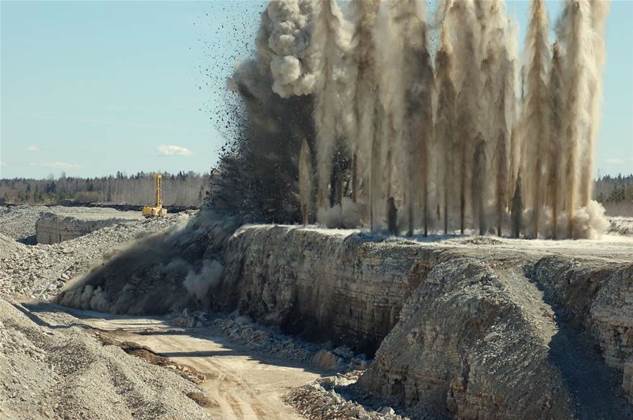Advanced detonation

Further into the blast lifecycle, Ian Gipps, CSIRO stream leader for non-entry underground mining, told iTnews that advanced methods of detonation have the potential to deliver greatly improved blasting accuracy.
"Currently all the detonators are connected up, mainly by electrical wiring," Gipps observed.
"Particularly underground, when you've got a large pattern where you might have ... up to 1000 holes, making sure you connect all the wires in the correct order can be a little difficult.
"With the electronic dets [detonators] it is not quite so critical.
"One of the other major areas where IT has come in, particularly in underground blasting, [is] through-rock radio communications to the blast and detonation circuit to set the detonation off, so that you can move away ... and [conduct the blast from] safer areas."
Gipps said radio detonators are another step towards mine site automation.
"One of the areas that will be much more important from the IT point of view will be the automation of explosive loading and explosive detonation; for further advanced blast control we need to go into automation of the explosive loading," he said.
Indeed, Rio Tinto announced last year it is trialling autonomous production drills designed to provide a reliable and repeatable process in blast-hole drilling.
The iron ore giant will use the integrated system to allow automated blast-hole drill rigs to precisely position the blast holes, conduct live rock analysis, dictate to the explosives delivery vehicle the correct explosive charge for each hole, and provide data supporting 3D mapping systems to provide detailed imaging of each deposit.
After the blast
As part of the blast lifecycle, miners are additionally undertaking ongoing analysis derived from routine monitoring.
Monitoring systems, conveying a variety of data via 3G, radio, or satellite links, process information in real-time.
BHP's Mt Arthur Blast Monitoring Program has six dedicated monitoring units permanently installed at specific locations throughout the coal mine's NSW Upper Hunter Valley site, feeding back into an automated web-based system, providing real-time vibration and overpressure data.
Rio Tinto subsidiary Coal & Allied's Mount Thorley Warkworth network, also situated in the Hunter Valley, consists of five real-time dust samplers, transmitting back to a central database, sending an alarm (on the basis of a rolling three hour average) to environmental personnel when particulate matter levels reach trigger levels at neighbouring residences.
Explosive video
Cocker additionally noted, as part of the post-blast monitoring process, most miners are now filming open-cut blasts, utilising modern video technology, providing high-definition, high-speed (ultra-slow motion) capabilities.
With consumer cameras capable of up to 300 frames per second also in use, there is now little reason for miners not to film in both high definition and at high speed.
"These [images] have the potential for quantitative assessment," he commented.
"Where permitted, markers, such as cuttings cones, can be suspended over the face; these are then picked up by the surveyors, together with camera locations.
"It will then be possible to calculate first burden movement times and face velocity profiles, as the marker movements are tracked by the video camera(s)."
Cocker noted modern video is an encompassing blast recording device, while a video archive can shed light on a pit's 'blastability', fuming and dust generation propensity.
"They are ideal for a quick qualitative overview of many key blast performance indicators," he commented.
"Timing accuracy, face profiles, flyrock and fuming timing and origins, and the final muckpile shape; if the video records are archived, they can be used to identify consistent blasting problems in particular areas of the pit."


.png&h=140&w=231&c=1&s=0)


_(20).jpg&h=140&w=231&c=1&s=0)



_(26).jpg&w=100&c=1&s=0)

 iTnews Executive Retreat - Security Leaders Edition
iTnews Executive Retreat - Security Leaders Edition











_(1).jpg&h=140&w=231&c=1&s=0)



